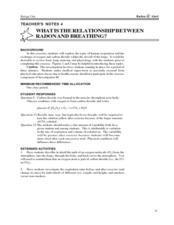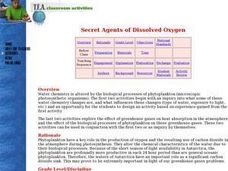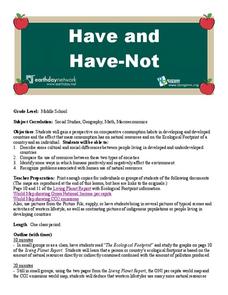Curated OER
Physics- global warming
Students discuss the concept of global warming and view a multimedia clip on the global warming phenomenon. They statistically analyze mean temperature data and compare a given set of data. Data on atmospheric CO2 is done then they...
Curated OER
What Is The Relationship Between Radon and Breathing?
Students examine the effects of radon on their breathing. They review the anatomy of the respiratory system before completeing this instructional activity. They also complete equations to show how carbon dioxide forms in their body.
Curated OER
Personal Emissions Calculator
Students complete the personal emissions grid and review information on carbon footprints. Using directions, they create their own emissions calculator and determine how much carbon dioxide they emit in a given period of time. They...
Curated OER
Eating Up Energy
Students will compare and contrast amount of energy consumption and CO2 emissions among the top ten user countries to understand global effects of emissions. They also map the global impact of energy consumption and CO2 emissions.
Curated OER
How Does Human Respiration Relate to Radon?
Learners examine the role of human respiration and how it relates to radon. They identify damage to the lung from the exchange of carbon dioxide and oxygen. They work together to complete a lab activity and worksheet.
Curated OER
Emissions Trading
Young scholars produce manufactured good, barter for sales, encounter government officials, make choices about emissions, trade carbon credits and share findings in order to understand how carbon trading could affect industry from an...
Curated OER
Virus Tracker
Sixth graders will simulate the spread of a virus such as HIV through a population by "sharing" (but not drinking) the water in a plastic cup with several classmates. Although invisible, the water in a few of the cups will already be...
Curated OER
Pointillist Portraits and More
Eighth graders discuss various medias and techniques artists use in portrait design. Using carbon paper and photos, 8th graders make four images on paper. They create portraits using felt tip pens, water colors, and colored pencils.
Curated OER
Every Tree For Itself
Fourth graders play a game where they are trees gathering sun, water, and nutrients and CO2 represented by pieces of paper or poker chips. They record their collected requirements and graph how they grew as a forest.
Curated OER
Quick Freeze (Demonstration)
Learners witness an demonstration in which a bottle of club soda will go from a liquid to a solid when it is opened and the carbon dioxide is allowed to escape. This will help them understand that the freezing point of a solution will...
Curated OER
Turn off your Engines!
Learners explore how idling vehicles contribute to the greenhouse gas emissions and climate change. They conduct a survey of idling in their community. Students calculate and develop corresponding graphs of the carbon dioxide produced...
Curated OER
Secret Agents of Dissolved Oxygen
Students determine the changes in different types of water in a sealed container over time. They investigate how to measure dissolved oxygen, temperature, and carbon dioxide with calculator or computer probe-ware. Students determine the...
Curated OER
Health, Pollution, and Safety: Why Should We Care?
Students examine the impact of reducing the carbon dioxide emissions. They identify ways alternative fuels can lessen the effect of emissions on communities. Working in teams they conduct research from various community and Internet...
Curated OER
Is Air a Fluid?
Students discuss the physical properties of fluids and then demonstrate that air carbon dioxide and oxygen) is a fluid by creating currents.
Curated OER
Solar Cars
Students research the causes and effects of air pollution. Using the internet, they examine the specific effects of carbon dioxide on the environment and discover the benefits of using solar power. In groups, they build a model of a...
Curated OER
Science: Quick Freeze
Students observe an experiment of freezing point depression using club soda. Through observation, they note that the carbon dioxide molecules disrupt the capacity of the water molecules to solidify. Precautions must be taken to assure...
Curated OER
What's Driving Us?
Middle schoolers determine what the people in their community are driving. Using traffic flow information, they develop recommendations on how to achieve sustainability. They calculate the carbon dioxide emission index for various sites...
Curated OER
Where Do Green Plants Get Energy?
Fourth graders realize that plants need light, water, and carbon dioxide to carry out photosynthesis. They participate in groups of 4 to plant (with materials provided) a test group of beans to compare to the control group, write a...
Curated OER
Half-Life Lab
Students participate in a lab in which they are introduced to carbon-dating. In groups, they use the holes of paper from a hole puncher and determine the rate of retention after shaking coins onto the same area. They record their...
Curated OER
LESSON PLANS (print version) pdf What is a Fossil?
Students can better explain how mould and cast fossils occur when they make their own cast fossils using plaster of Paris and objects such as shells, bone or even their own hand or footprint.
Curated OER
Environment: The Haves and the Have Nots
Students examine consumption habits in developed and developing countries and determine their effects on natural resources. In groups, they assess graphs on the Living Planet Report and observe the connection between consumption and...
Curated OER
Seltzer Breath
Young scholars investigate "indicator" (Bromothymol Blue or BTB) to test for the presence of certain chemicals in liquids and gases. They compare distilled water and seltzer water for presence of carbon dioxide.
Curated OER
Gases Around Us
In this gasses worksheet, students write information about hydrogen, oxygen, natural gas, helium, anesthetic gas, and carbon dioxide in pictures of clouds.
Curated OER
Worksheet: Phase Diagrams
In this phase diagram worksheet, students complete 7 fill in the blank questions about three different diagrams. Triple point, critical pressure, and critical temperature for water and carbon dioxide are examples of items identified on...























